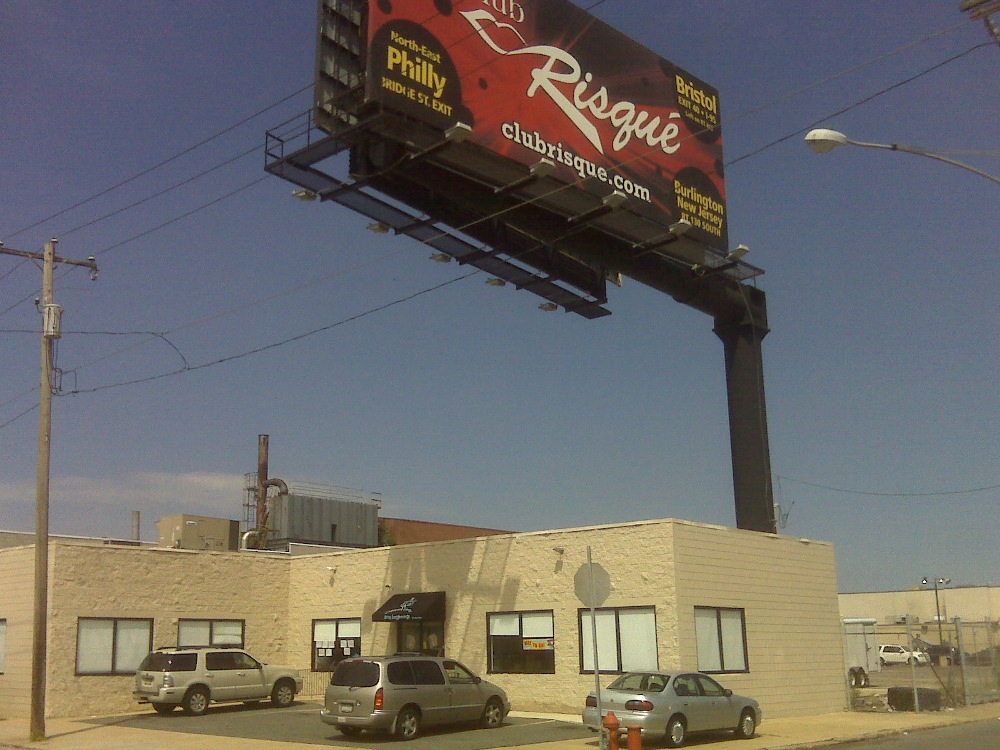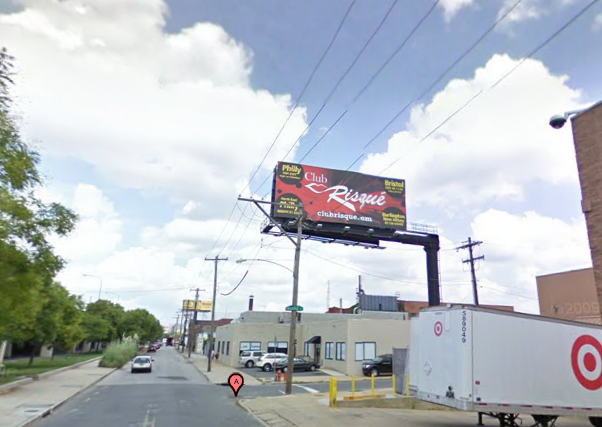Ordinance to make Pennsport billboard legal and digital headed to council
UPDATED
A zoning bill that would allow the owner of a conventional Pennsport billboard advertising Club Risque and a suburban body shop that L&I says should come down may get to keep his billboard as is – or even replace it with a digital one.
A legislative proposal allowing one billboard that can have changeable, electronic messages and advertise a non-accessory use within the area bounded by Moore, Swanson, Morris and Water streets and Columbus Boulevard passed out of City Council’s rules committee this week and heads to full council for a vote.
Depending on whom you ask, this would either be a huge victory for a local businessman who has tried to follow L&I rules to bring the billboard into compliance only to be told the rules have changed (property owner attorney Ron Patterson), or a “classic example of spot zoning” that “circumvents the protections contained in the City’s Sign Control Laws” (Mary Tracy, founding member of the Society Created to Reduce Urban Blight, aka, SCRUB).
Rules approved the proposal, sponsored by First District Councilman Frank DiCicco, despite the Philadelphia City Planning Commission’s recommendation that they should not.
At Tuesday’s hearing, Stephanie Kindt, SCRUB’s in-house attorney, described a year’s-long battle waged by her organization and Pennsport Civic Association fighting the billboard. But DiCicco said that while Pennsport Civic Association once opposed the legislation, he received a call from the group’s new president saying it no longer does.
But there seems to be a bit of disagreement about that in Pennsport.
On Wednesday afternoon, Dr. James Moylan, who was elected president of Pennsport Civic Association last month, said that DiCicco had it right.
It’s not that Pennsport wants the billboard, it’s that the volunteer organization doesn’t really have the time and money to spend fighting this single billboard, which already exists. The association believes it makes more sense to focus their energy on the bigger picture, working on new zoning that will keep more billboards like this from going up in the future, Moylan said.
“I’d rather put our efforts into the larger picture – how we can control things in the future so we don’t end up with 15 more of these,” he said. “We can’t continue putting out little fires.”
But at Thursday’s Central Delaware Advocacy Group meeting, past civic association president Tom Otto, who remains on the board, said that Pennsport Civic is still fighting the legislation. At Wednesday night’s association meeting, Otto said, the consensus was that the billboard should come down altogether, because it is in violation of current zoning.
Should city council pass the legislation, the billboard owner, whom Moylan said he does not know personally, should expect to hear from Pennsport Civic, the new president said. As should other new businesses coming to the neighborhood.
That’s not to say that Moylan wasn’t disappointed when DiCicco introduced zoning bill 110306 earlier this spring. “The bill was put through, and nobody contacted us initially,” he said. “It was like, ‘what the hell is going on now?’” Pennsport Civic expressed its displeasure to the planning commission when they considered the bill, Moylan said. Both Pennsport and Neighbors Allied for the Best Riverfront submitted letters of opposition.
But Moylan said he “saw the writing on the wall. There was a good chance of this passing, and there is more time and money on that side than there is on ours,” he said. “The idea is to protect the community as best as possible, in the larger sense.”
Moylan wants to negotiate a community benefits agreement with this and other business owners, getting consessions that address development concerns like traffic flow and generating revenue Pennsport can use for neighborhood improvements such as street cleaning and trees, playgrounds and after-school programs.
On Thursday, Otto said that if the measure passes, Pennsport absolutely will negotiate with the billboard owner. It would be preferable to keep the billboard the standard type rather than the digital type, he said. And if the billboard goes digital, Otto said there are big concerns about it advertising Club Risque with scantilly clad women – particularly since there is a daycare center on the property.
“I’d like to sit down with the owner,” Otto said. But Plan A is still fighting the legislation and “knocking the whole billboard out,” he said.
At Tuesday’s Rules Committee hearing, Bill Kramer, the planning commission’s development division director, said that if passed, the bill would allow a situation that was detrimental to public safety. Kindt said studies have shown that digital billboards are a distraction.
But neither DiCicco nor committee chair, Councilman-at-Large James Kenney, were having any of that. Kenney wanted proof. DiCicco said that as a former member of the Delaware River Port Authority, he had first-hand information that the two digital billboards on the Philadelphia side of the Walt Whitman Bridge have had zero impact on traffic safety.
Attorney Patterson said the bill would be “a way to correct a wrong.”
The owner of the sign, 1700 Columbus Associaties, applied for a non-accessory use variance in 2007, and was turned down by the Zoning Board of Adjustment. The ZBA decision was reversed on appeal in Common Pleas court, then reaffirmed by Commonwealth Court in 2009.
Since his client was told the signs were not legal because they advertised things that were off-site, he put a trailer on the property, where the offices of the auto shop and Club Risque are both located, Patterson said. But L&I still wouldn’t issue the permit, he said. “We were told ‘We don’t believe these are legitimate offices. Go to the zoning board.’ We tried to follow the rules,” Patterson said.
Kindt, who testified that her organization and the neighbors near the sign have been opposed to this on-going issue since 1989, indicated she didn’t think the offices in the trailer were a legitimate reason to consider the sign accessory, either. “Those businesses just got their permits last July,” she said.
Kenney said he could really see no difference between a nearby sign for Target and the billboard, and asked Kindt pointedly why one concerned SCRUB and the other didn’t.
Kindt said the Target sign is an accessory sign on the Target property that tells people who want to go to Target how to get there.
“To me, I don’t see much difference,” Kenney said.
He wasn’t the only one frustrated by the discussion.
SCRUB’s Tracy said signs are supposed to be farther than 600 feet from a school or daycare, and this one is adjacent to a daycare. The sign has been issued six different citations, Kindt said. “To legalize this would reward the property owner for years of non-compliance,” she said.
Contact the reporter at kgates@planphilly.com
WHYY is your source for fact-based, in-depth journalism and information. As a nonprofit organization, we rely on financial support from readers like you. Please give today.





